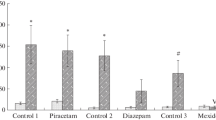Abstract
A discrimination conditioned active avoidance reflex (CAAR) model in a T maze was used in 18 rats to study the effects of bilateral microinjections of the selective muscarinic M1 receptor blocker pirenzepine into the neostriatum on the acquisition of the CAAR and behavior in an open field test. There was sharp degradation of learning of the CAAR and a significant improvement in motor activity both in the open field test and in the maze itself in rats given bilateral microinjections (pirenzepine, 0.004 mg) into the neostriatum as compared with intact controls. This suggests that changes in motor behavior (a sharp increase in locomotor activity) may be among the reasons for difficulty in learning the CAAR in rats after pirenzepine microinjections. Another reason for difficulty in learning the CAAR in these animals may be impairment of the perception of the conditioned signals (a flashing light) and poor differentiation. This is particularly indicated by the delay in the start chamber (double that seen in intact animals) on presentation of conditioned signals despite the high level of motor activity. These results and published data provide evidence for the complex nature of changes induced by blockade of muscarinic M1 receptors in the neostriatum.
Similar content being viewed by others
REFERENCES
V. N. Khokhlova, G. Kh. Merzhanova, and E. E. Dolbakyan, “The role of muscarinic cholinoreceptors in the reproduction of an operant food-related conditioned reflex in cats,” Zh. Vyssh. Nerv. Deyat., 50, No.3, 282–491 (2000).
K. B. Shapovalova, “The cholinergic system of the striatum: involvement in the motor and sensory components of movement behavior. A. review,” Zh. Vyssh. Nerv. Deyat., 47, 123–134 (1987).
K. B. Shapovalova, “Activation of the cholinergic system of the striatum improves attention to conditioned reflex stimuli,” Ros. Fiziol. Zh. im. I. M. Sechenova, 84, No. 7, 602–610 (1998).
K. B. Shapovalova, “Muscarinic receptors of the neostriatum-involvement in the control of operant behavior in dogs,” Ros. Fiziol. Zh. im. I. M. Sechenova, 89, 1404–1417 (2000).
K. B. Shapovalova, E. V. Pominova, and T. A. Dyubkacheva, “Characteristics of the effects of the cholinergic system of the neostriatum in rats on learning active avoidance in normal conditions and after lesioning of the intralaminar nuclei of the thalamus,” Ros. Fiziol. Zh. im. I. M. Sechenova, 82, No.1, 1–12 (1996).
K. B. Shapovalova, T. A. Dyubkacheva, V. N. Chikhman, D. A. Mysovskii, and Yu. V. Kamkina, “Operant behavior in conditions of activation and blockade of muscarinic receptors in the neostriatum,” Ros. Fiziol. Zh., 88, No.9, 1146–1160 (2002).
A. F. Yakimovskii, Involvement of the Dopaminergic and Enkephalinergic Systems of the Caudate Nucleus in Controlling Conditioned Reflex Activity [in Russian], Author’s abstract of thesis, Leningrad (1984).
A. Blokland, “Acetylcholine: a neurotransmitter for learning and memory?” Brain Res. Rev., 21, 285–299 (1996).
P. J. Bushnell, W. M. Oshiro, and B. K. Pandas, “Detection of visual signals by rats: effect of chlordiazepoxide and cholinergic and adrenergic drugs on sustained attention,” Psychopharmacol., 134, 280–289 (1997).
B. J. Everitt and T. W. Robbins, “Central cholinergic system and cognition,” Ann. Rev. Psychol., 48, 649–663 (1997).
D. N. Jones and G. A. Higgins, “Effect of scopolamine on visual attention in rats,” Psychopharmacol., 120, 142–156 (1995).
P. M. Moran, “Scopolamine deficit in negative patterning discrimination: evidence for a role of the central cholinergic system in retention but not acquisition of non-spatial configural association learning,” Behav. Brain Res., 48, 187–202 (1992).
T. W. Robbins, “Arousal system and attentional process,” Biol. Psychol., 45, 57–71 (1997).
M. Sarter and J. P. Bruno, “Cognitive functions of cortical acetylcholine: toward a unifying hypothesis, ” Brain Res. Rev., 23, 28–46 (1997).
H. Sato, Y. Hata, H. Masar, and T. A. Tsumoto, “A functional role of cholinergic innervation to neurons in the cat visual cortex,” J. Neurophysiol., 58, 765 (1987).
K. B. Shapovalova, “Possible mechanism of the neostriatum in regulation of voluntary movement,” in: Soviet Scientific Reviews, T. M. Turpaev (ed.), Harwood Academic Publishers, Vol. 6, Part 3, pp. 1–90 (1993).
K. B. Shapovalova, “The striatal cholinergic system and instrumental behavior,” in: Complex Brain Function. Conceptual Advances in Russian Neuroscience, Miller et al. (eds.), Harwood Press, London (2000), pp. 263–288.
K. B. Shapovalova, “The neostriatal muscarine receptors and regulation of voluntary movement and posture in dogs,” in: Sensorimotor Control, R. Dengler and A. Kossev (eds.), NATO Science Series, IOS Press (2001), pp. 132–137.
K. B. Shapovalova, “Muscarinic receptors of the dorsal striatum: role in regulation of motor behavior, ” in: Basal Ganglia and Thalamus in Health and Movement Disorders, I. Ilinksy and K. Kultas-Ilinsky (eds.), Kluwer Academic, Plenum Publishers, New York (2001), pp. 163–171.
A. Van Hest, J. Stroct, F. Van Haaren, and M. Feenstra, “Scopolamine differentially disrupts the behavior of male and female Wistar rats in a delayed nonmatching to position procedure,” Pharmacol. Biochem. Behav., 35, 903–915 (1990).
Author information
Authors and Affiliations
Additional information
Translated from Rossiiskii Fiziologicheskii Zhurnal imeni I. M. Sechenova, Vol. 90, No. 2, pp. 129–136, February, 2004.
Rights and permissions
About this article
Cite this article
Shapovalova, K.B., Kamkina, Y.V. & Mysovskii, D.A. The Effects of Microinjection of the Selective Blocker of Muscarinic M1 Receptors Pirenzepine into the Neostriatum on the Motor Behavior of Rats. Neurosci Behav Physiol 35, 589–594 (2005). https://doi.org/10.1007/s11055-005-0098-x
Received:
Issue Date:
DOI: https://doi.org/10.1007/s11055-005-0098-x



